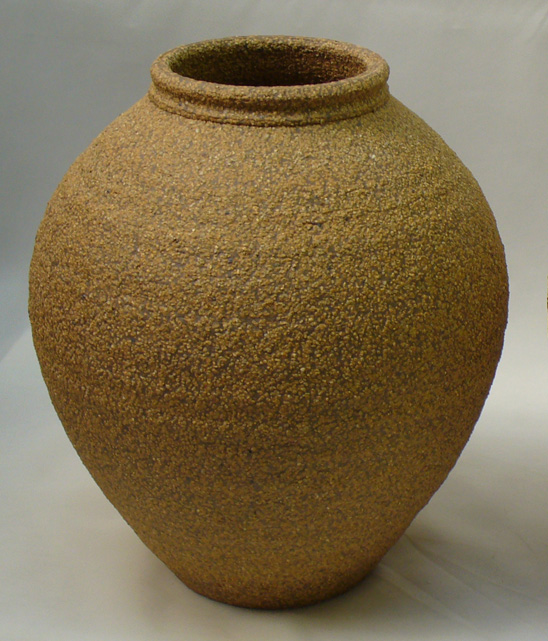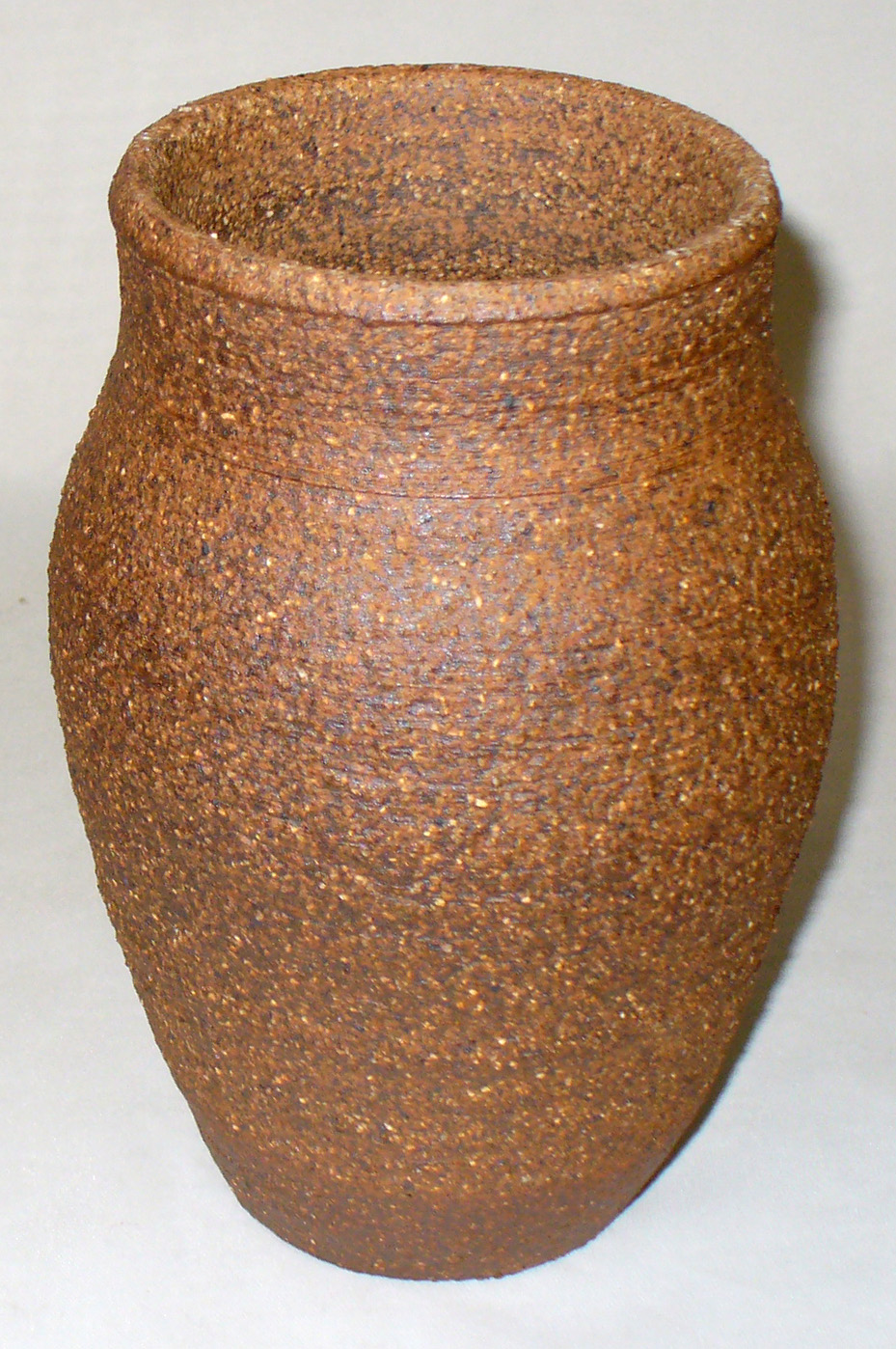| Monthly Tech-Tip | No tracking! No ads! | |
Redart
Alternate Names: Red Art
Description: Red Firing Earthenware
| Oxide | Analysis | Formula | Tolerance |
|---|---|---|---|
| CaO | 0.26% | 0.03 | |
| K2O | 4.15% | 0.29 | |
| MgO | 1.59% | 0.26 | |
| Na2O | 0.38% | 0.04 | |
| TiO2 | 1.09% | 0.09 | |
| Al2O3 | 15.51% | 1.00 | |
| P2O5 | 0.22% | 0.01 | |
| SiO2 | 64.95% | 7.11 | |
| Fe2O3 | 7.05% | 0.29 | |
| LOI | 4.80% | n/a | |
| Oxide Weight | 626.07 | ||
| Formula Weight | 657.64 | ||
Notes
Jan 2022: We got reports of Redart properties possibly showing some variation, we arranged testing on separate shipments arriving at different places and spanning a year. The results for drying shrinkage, water of plasticity, drying performance and fired shrinkage were very similar for all.
Redart is a red-firing earthenware of moderate to low plasticity and low shrinkage. It fires light orange to dark red depending on firing temperature from cone 06 to 3. It fires much stronger and denser at cone 04 than 06 and achieves its best color/strength compromise at cone 02. It produces deep red color and stoneware properties at cone 1. It is air-floated to 200 mesh and has a long firing range. This is a very popular ingredient in clay bodies made across North America and it has been available for many years.
This material is quite high in iron thus the powder is a deep red color and quite messy to work with. Redart is also used by potters in glaze recipes, sometimes up to 60%.
Redart can be used as a primary component in brown and red burning modeling and low-temperature throwing bodies. Since Redart is not plastic it needs help from bentonite ball clay and bentonite. The L4170BP recipe is a good example.
Redart can be used to make casting bodies without any other additions. It will produce very good red color and will deflocculate and cast well. It is possible that a small addition of plastic clay might be needed to give it better strength to pull away from the mold. Also, additions of silica (for glaze fit) and a frit (for maturity) are also options. The L4170B recipe is a good starting point, it is 90% Redart.
While Redart can be used as a source of iron in high temperature bodies, it will produce brown rather than red coloration. This is because the fluxes are intimately mixed with the iron and fuse it to a darker color. To get red in oxidation or reduction at higher temperatures you must use refractory clays with iron or iron bearing fireclays. However there is good reason not to use low fire reds as fluxes in high fire bodies: The fluxes in the red clays don't dissolve cristobalite like feldspar does, the result can be thermal expansion related ware failure.
This material is mined from a large deposit and the company is confident in its consistency and long term availability.
Related Information
Original container bag of Redart

This picture has its own page with more detail, click here to see it.
Back side of Redart original container bag

This picture has its own page with more detail, click here to see it.
This clay is called Redart for a good reason

This picture has its own page with more detail, click here to see it.
Redart fired bars vs. Plainsman Blue Grey Plastic

This picture has its own page with more detail, click here to see it.
The Redart clay bars (left) are fired at cones 06, 04, 2, 4 & 5 (top to bottom). The Plainsman Blue Grey Plastic bars (right) are fired at 06, 04, 03, 02, 2 & 4. The SHAB test procedure (used to make these) gives us the firing shrinkage and porosity at each temperature, these are direct indicators of the fired maturity. Notice how much the fired color changes with increasing temperature. The fired maturity is pretty similar but the BGP is a little browner in color. It is also much more plastic (the drying shrinkage quite a bit higher).
Redart (left) vs. Lizella clay. Definitely not substitutes for each other.

This picture has its own page with more detail, click here to see it.
These bars have been fired at cones 4, 2, 02, 04 (top to bottom) using the SHAB testing procedure. We can measure fired shrinkage and porosity in each to get an indication of their fired maturity. The Redart (left) is much more vitreous and reaches almost zero porosity by cone 4 whereas the Lizella still has 11% porosity at cone 4. Lizella also has a much higher drying shrinkage (because it is way more plastic).
Redart-as-a-glaze wood-fired on Laguna B-Mix

This picture has its own page with more detail, click here to see it.
Fired to cone 13 in a Manabigama wood fired kiln.
Melt fluidity and coverage: RedArt Slip vs. Albany Slip vs. Alberta Slip

This picture has its own page with more detail, click here to see it.
These three melt flows and mugs were fired at cone 6 (using the C6DHSC firing schedule). The benchmark recipe is 80% clay and 20% Ferro Frit 3195 (our standard GA6-B recipe).
-The center melt flow (and matching buff stoneware mug below) employ the original Albany Slip.
-The one on the right employs Alberta Slip. Notice that, although having a very similar melt flow, it needs an iron oxide addition to darken the color (e.g. 2%).
-The one on the far left uses an Albany Slip substitute made from 80% Redart, 6.5% calcium carbonate, 6.5% dolomite and 6.5% nepheline syenite (our code L3613D). The chemistry of RedArt is different enough from Albany that some compromises were needed to avoid over-supplying the iron even more (and firing darker yet). Although this Redart version runs in a very similar pattern on the melt flow, the character of the glaze on the mug reveals it needs a little more melting (increasing the frit percentage would take care of that).
Wow, what a surface. How?

This picture has its own page with more detail, click here to see it.
A cone 10R sculpture clay containing 40% ball clay, 10% kaolin, 10% low fire redart (for color and maturity), some quartz and 25% 20x48 grog. This fine grained base produces a body that feels smoother than it really is and is very plastic. It is even throwable on the wheel.
Cone 10R heavily grogged vitreous body that actually throws

This picture has its own page with more detail, click here to see it.
This is a grog clay with 25% Christy Minerals STKO22S grog (20 mesh one size). This piece is about 8 inches tall fired at cone 10R. This body is a Redart, Ball clay base that totally vitrifies to a chocolate brown. But with the added refractory grog it is fairly stable in the kiln and is much more vitreous than other grog bodies. Because it is such a plastic smooth base and because the grog is only one size, this is actually throwable. And it is very resistant to splitting during hand building.
M2 vs. Redart

This picture has its own page with more detail, click here to see it.
Plainsman M2 (left) vs. Redart (right). These bars are fired cone 04, 02, 2, 3, 4 (top to bottom). Fired color is almost identical. M2 has a little more soluble salts (however M2 has no chemical additions to precipitate them, it is ground as the pure mined material). M2 is more plastic (although still not as plastic as a typical pottery clay). However, Redart will make a good casting slip while M2 does not respond to deflocculants.
A Redart cone 03 body shines when it come to ease of glaze fit

This picture has its own page with more detail, click here to see it.
These bowls are fired at cone 03. They are made from 80 Redart, 20 Ball clay. The glazes are (left to right) G1916J (Frit 3195 85, EPK 15), G191Q (Frit 3195 65, Frit 3110 20, EPK 15) and G1916T (Frit 3195 65, Frit 3249 20, EPK 15). The latter is the most transparent and brilliant, even though that frit has high MgO. The center one has a higher expansion (because of the Frit 3110) and the right one a lower expansion (because of the Frit 3249). Yet all of them survived a 300F to icewater IWCT test without crazing. This is a testament to the utility of Redart at low temperatures. A white body done at the same time crazed the left two.
Brown soluble salts that appear after drying, but disappear on firing

This picture has its own page with more detail, click here to see it.
The soluble salts dissolved in the water of plasticity of this red body have migrated through the white engobe during drying of these earthenware cups. The cups were upside down so all the solubles have been left on the outside surface. The red body is made using a high percentage of Redart clay (a widely available commercial low-fire low-plastic clay in North America). It is plasticized using added ball clay. The brownish material is organic, because after bisque firing it has disappeared.
Body frit makes Redart a stoneware

This picture has its own page with more detail, click here to see it.
Stoneware at cone 02? Yes. These test bars are fired to cone 02. The top body is 50:50 Redart and a silty raw material from Plainsman Clays (named 3D) plus some bentonite and 1% iron. The bottom one also has 5% Ferro Frit 3110. The porosity: The bottom one is 3%, the top one 8%. So each 1% frit reduces the porosity by 1% in this case.
Links
| Articles |
Understanding the Deflocculation Process in Slip Casting
Understanding the magic of deflocculation and how to measure specific gravity and viscosity, and how to interpret the results of these tests to adjust the slip, these are the key to controlling a casting process. |
| Articles |
Understanding the Terra Cotta Slip Casting Recipes In North America
This article helps you understand a good recipe for a red casting body so that you will have control and adjustability. |
| URLs |
http://www.rescoproducts.com/pds/Ceramic%20Clays.pdf
Resco Clays Data Sheet |
| Materials |
Goldart
|
| Materials |
Ceramic Fireclay
|
| Materials |
Roseville Clay
|
| Materials |
Salt Lick
|
| Materials |
Carbondale Clay
|
| Materials |
Newman Red Clay
|
| Materials |
Redearth
|
| Materials |
Banta Red Clay
|
| Materials |
Lizella Clay
|
| Typecodes |
Clay Other
Clays that are not kaolins, ball clays or bentonites. For example, stoneware clays are mixtures of all of the above plus quartz, feldspar, mica and other minerals. There are also many clays that have high plasticity like bentonite but are much different mineralogically. |
Data
| Drying Shrinkage | 5.5% |
|---|---|
| Firing Shrinkage | Cone 04: 3% Cone 2: 8% |
| Water absorption | Cone 04: 11% Cone 2: 1% |
Mechanisms
| Body Maturity | Red terra cotta clays are typically 6-8 cones more vitreous than is possible with feldspar-white clay mixes. Thus where a red clay can be tolerated, materials like this can be employed to create cone 02-2 stoneware. |
|---|
| By Tony Hansen Follow me on        |  |
Got a Question?
Buy me a coffee and we can talk

https://digitalfire.com, All Rights Reserved
Privacy Policy
